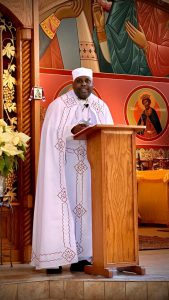
By Father Pasquale Armando Francesco
(parochial vicar at the Cathedral of Saint Joseph)
I’d like to share with you some of the lenten practices from Northeast Africa, where I am from. I’m going to focus on fasting, as there are many beautiful practices full of meaning and grace.
It may be helpful to first know some of the seven different Catholic rites: Latin, Byzantine, Alexandrian, Syriac, Armenian, Maronite and Chaldean. These rites have their own liturgical ways of celebrating the Mass and sacraments, and they have varied ways of how things are to be done in terms of location, culture and traditions. This makes the Catholic Church colorful and rich.
What are the rites in African churches?
In some Eastern and Northeastern African countries, there is the Alexandrian Rite. In Egypt, it is the Catholic Coptic Rite. The Alexandrian Rite, which is also called Catholic Ge’ez Rite, is in Ethiopia and Eritrea. Other parts of Africa follow the Western Rite or Latin Rite.
Fasting in Northeast Africa is a bit serious and different because of their neighborhood religions and other Christian believers like Coptic Orthodox and Ge’ez Orthodox.
The Ethiopian and Eritrean liturgical calendars have seven major fasts in a year, which I will describe below. Some of the fasts may have different dates from one year to the next, depending on whether the year is a leap year or not. The fasting dates listed below can be converted using the Ethiopian calendar converter.
- Abiy Tsome (Fast of Great Lent)
Abiy Tsome, or the Fast of Great Lent in Ethiopia and Eritrea, is a period of strict fasting and prayer observed by Ethiopian and Eritrean Orthodox Tewhado Christians (influenced by neighborhood Christian tradition) during the season of Great Lent, which occurs in the lead-up to Easter. It is marked by abstaining from certain foods such as meat, dairy and eggs, and by increasing one’s participation in church services and other spiritual practices. The fast of Great Lent is seen as a time of spiritual cleansing and renewal, and is considered a crucial part of the Ethiopian Orthodox Christian faith.
Abye Tsome (Lent), a 55-day fast before Easter, is the longest and most intensive one in the Ethiopian and Eritrean Orthodox and Catholic fasting calendar. It also includes Tsome Himamat, a seven-day fast that starts on the Monday after Palm Sunday until Easter, a holy week that commemorates Jesus Christ’s travel into Jerusalem before his time of suffering, Crucifixion and Resurrection.
- Tsome Hawariat (Fast of the Apostles)
Tsome Hawariat, also known as the Fast of the Apostles, commemorates the time when the Apostles of Jesus received the gift of the Holy Spirit and their immediate devotion for fasting and prayer to be fully prepared for their mission of spreading the message of Jesus Christ. They then set out from Jerusalem to share the teachings of Jesus Christ with the world. Tsome Hawariat begins on the first Monday after Pentecost and lasts between 14 and 44 days, always ending on July 5.
- Tsome Nenewe (Fast of Nineveh)
Tsome Nenewe, or the Fast of the Ninevites in Ethiopia and Eritrea, is a fast observed by some members of both the Orthodox and Catholic Church. It is based on the biblical story of Jonah and the city of Nineveh, in which Jonah was sent by God to deliver a message of repentance to the people of Nineveh. When the people of Nineveh heard Jonah’s message, they repented and fasted in order to seek God’s forgiveness. The Fast of the Ninevites in Ethiopia and Eritrea is observed as a way to honor this act of repentance and to seek God’s mercy and forgiveness. It is typically observed for three days, during which believers abstain from food, drink and other pleasures. It is usually observed in the lead-up to the Ethiopian Christmas, which is celebrated on Jan. 7. This fasting period begins on the Monday following the feast day of the Exaltation of the Holy Cross and lasts for three days.
- Tsome Filseta (Fast of the Assumption of Blessed Virgin Mary)
The Fast of the Holy Mary is observed by both Catholic and Orthodox Christians in honor of the Blessed Virgin Mary. It is held in August and lasts for 14 days. During this time, believers abstain from all food and drink from sunrise to sunset and spend their days in prayer and devotion to the Virgin Mary.
The Fast of the Holy Mary is seen as a way to honor the mother of Jesus, and to seek her intercession and guidance in the face of difficult challenges and hardships. This fasting period begins on the Monday following the Feast of the Assumption of the Blessed Virgin Mary and lasts for two weeks. It is Aug. 7-21 (fixed date).
- Tsome Nebiyat (Fast of the Prophets)
Tsome Nebiyat, or the Fast of the Prophets, is a period of fasting and prayer that commemorates the lives and teachings of the prophets of the Old Testament of the Ethiopian Orthodox Bible. The Fast of the Prophets is considered a time of spiritual renewal and is an important part of Ethiopian and Eritrean Orthodox Christian faith. This fasting period begins on the Monday following the Ethiopian and Eritrean Christmas and lasts for 43 days from Nov. 25 to Jan. 6 (fixed date).

- Tsome Gehad (Fast of the Vigils)
Tsome Gehad is a period of fasting observed by Ethiopian Orthodox Christians. It is held in the weeks leading up to the Feast of the Annunciation, which commemorates the announcement of the birth of Jesus to the Virgin Mary. The Fast of the Vigils is a time of spiritual reflection and preparation for the Feast of the Annunciation. This fasting day takes place the eve of the Ethiopian Christmas and the day before Epiphany, which is the Baptism of Our Lord (Dec. 28 and Jan. 10/18 fixed date).
- Tsome Dihinet (Fast of Wednesdays and Fridays)
Tsome Dihinet, or the Fast of Wednesdays and Fridays in Ethiopia and Eritrea, is a practice observed by most Orthodox Tewhado and Catholic Christians. They traditionally abstain from eating animal products and other rich foods on Wednesdays and Fridays as a way to practice self-discipline and devotion. This practice is based on the belief that Wednesday was the day that Jesus was betrayed by Judas Iscariot, and Friday was the day of Jesus’ crucifixion.
Fasting on these days is a way for believers to show their devotion to Jesus and to remember his suffering. People are more devoted to these spiritual ways of observing Christian fasts and in some regions, even restaurants sell no animal products on these days. This fasting is carried out during Wednesdays and Fridays throughout the year, except for the 50 days after Easter.
In addition to these major fasting periods, the Ethiopian Orthodox Church has several minor fasting periods throughout the year. These may involve partial fasts or abstention from certain foods, such as meat or dairy and they are usually frequented by monks, priests and senior members of the Church.


